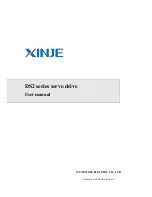
ASDA-A3
Operation Mode
Revision December, 2017
6-3
6
6.1 Selecting the operation mode
This servo drive provides three basic operation modes: Position, Speed, and Torque. The
available communication modes are CANopen, DMCNET and EtherCAT respectively. For basic
operation mode, you can choose from Single mode, Dual mode, and Multi-mode. The following
table lists all the available modes.
Mode
Short name
Code
Description
Single
mode
Position mode
(Terminal block
input)
PT
00
The servo drive receives the Position command
and commands the motor to run to the target
position. The Position command is communicated
through the terminal block and the signal type is
pulse.
Position mode
(Register input)
PR
01
The servo drive receives the Position command
and commands the motor to run to the target
position. Position commands are issued from the
internal registers (99 sets in total). You can select
the register number with DI signals or through
communication.
Speed mode
S
02
The servo drive receives the Speed command and
commands the motor to run at the target speed.
The Speed command is issued from the internal
registers (3 sets in total) or by analog voltage
(-10V to +10V) which is communicated through the
terminal block. You select the command with DI
signals.
Speed mode
(No analog input)
Sz
04
The servo drive receives the Speed command and
commands the motor to run at the target speed.
The Speed command can only be issued from the
internal registers (3 sets in total) instead of through
the external terminal block. You select the
command with DI signals.
Torque mode
T
03
The servo drive receives the Torque command and
commands the motor to run with the target torque.
The Torque commands can be issued from the
internal registers (3 sets in total) as well as by
analog voltage (-10V to +10V) which is
communicated through the terminal block. You
select the command with DI signals.
Torque mode
(No analog input)
Tz
05
The servo drive receives the Torque command and
commands the motor to run with the target torque.
The Torque command can only be issued from the
internal registers (3 sets in total). You select the
command with DI signals.
Dual mode
PT-S
06
You can switch PT and S mode with DI signals.
PT-T
07
You can switch PT and T mode with DI signals.
PR-S
08
You can switch PR and S mode with DI signals.
PR-T
09
You can switch PR and T mode with DI signals.
S-T
0A
You can switch S and T mode with DI signals.
-
0B
Reserved
Communication
0C
DMCNET mode
CANopen mode
EtherCAT mode
PT-PR
0D
You can switch PT and PR mode with DI signals.
Multi-mode
PT-PR-S
0E
You can switch PT, PR, and S mode with DI
signals.
PT-PR-T
0F
You can switch PT, PR, and T mode with DI
signals.
Summary of Contents for ASD-A3-0121
Page 13: ...Revision December 2017 This page is intentionally left blank...
Page 43: ...Installation ASDA A3 2 20 Revision December 2017 2 This page is intentionally left blank...
Page 105: ...Wiring ASDA A3 3 62 Revision December 2017 3 This page is intentionally left blank...
Page 187: ...Operation Mode ASDA A3 6 36 Revision December 2017 6 This page is intentionally left blank...
Page 467: ...Parameters ASDA A3 8 210 Revision December 2017 8 This page is intentionally left blank...
Page 577: ...Specifications ASDA A3 A 28 Revision December 2017 A This page is intentionally left blank...
Page 597: ...Accessories ASDA A3 B 20 Revision December 2017 B This page is intentionally left blank...
Page 603: ...4 Revision December 2017 This page is intentionally left blank...
















































